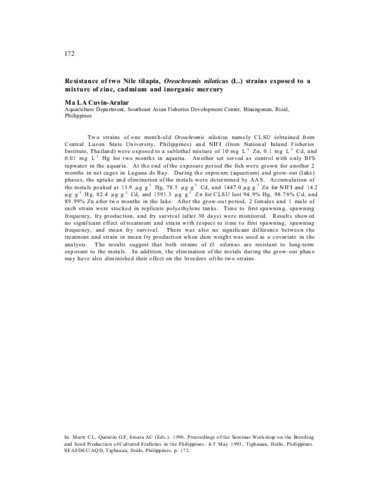Resistance of two Nile tilapia, Oreochromis niloticus (L.) strains exposed to a mixture of zinc, cadmium and inorganic mercury
Share
Abstract
Two strains of one month-old Oreochromis niloticus namely CLSU (obtained from Central Luzon State University, Philippines) and NIFI (from National Inland Fisheries Institute, Thailand) were exposed to a sublethal mixture of 1.0 mg L-1 Zn, 0.1 mg L-1 Cd, and 0.01 mg L-1 Hg for two months in aquaria. Another set served as control with only BFS tapwater in the aquaria. At the end of the exposure period the fish were grown for another 2 months in net cages in Laguna de Bay. During the exposure (aquarium) and grow-out (lake) phases, the uptake and elimination of the metals were determined by AAS. Accumulation of the metals peaked at 13.9 µg g-1 Hg, 78.5 µg g-1 Cd, and 1447.0 µg g-1 Zn for NIFI and 14.2 µg g-1 Hg, 82.4 µg g-1 Cd, and 1591.3 µg g-1 Zn for CLSU lost 94.9% Hg, 98.76% Cd, and 89.99% Zn after two months in the lake. After the grow-out period, 2 females and 1 male of each strain were stocked in replicate polyethylene tanks. Time to first spawning, spawning frequency, fry production, and fry survival (after 30 days) were monitored. Results showed no significant effect of treatment and strain with respect to time to first spawning, spawning frequency, and mean fry survival. There was also no significant difference between the treatment and strain in mean fry production when dam weight was used as a covariate in the analysis. The results suggest that both strains of O. niloticus are resistant to long-term exposure to the metals. In addition, the elimination of the metals during the grow-out phase may have also diminished their effect on the breeders of the two strains.
Suggested Citation
Cuvin-Aralar, M. L. A. (1996). Resistance of two Nile tilapia, Oreochromis niloticus (L.) strains exposed to a mixture of zinc, cadmium and inorganic mercury. In C. L. Marte, G. F. Quinitio, & A. C. Emata (Eds.), Proceedings of the Seminar-Workshop on Breeding and Seed Production of Cultured Finfishes in the Philippines, Tigbauan, Iloilo, Philippines, 4-5 May 1993 (p. 172). Tigbauan, Iloilo, Philippines: Aquaculture Department, Southeast Asian Fisheries Development Center.


